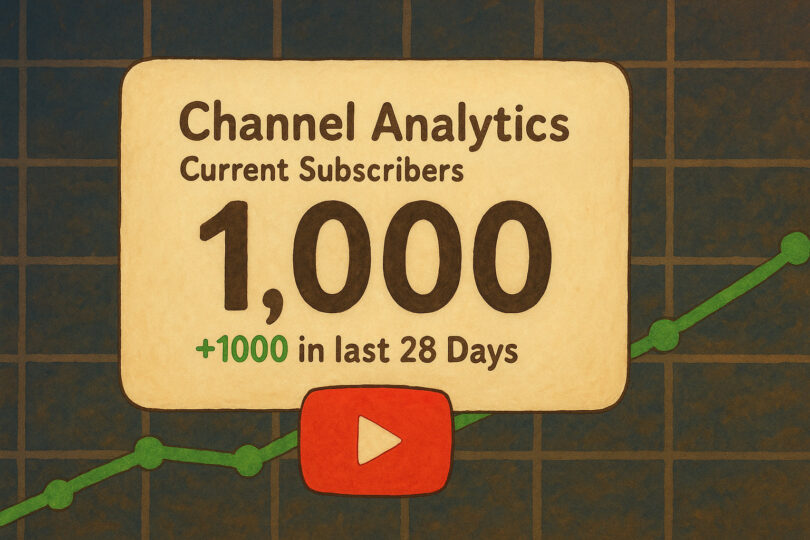Getting your first 1,000 YouTube subscribers is a major milestone for any creator. It’s not just a number—it’s proof that people care about your content and want to see more of it. But here’s the truth: most YouTubers struggle for months or even years trying to hit this mark. Why? Because they’re focusing on the wrong things—like editing, thumbnails, or titles—while ignoring the real secret behind explosive growth.
In this article, you’ll discover a powerful but often overlooked method that helped multiple channels reach 1000 subscribers in just 30 days , including my own personal experience. This isn’t some “get rich quick” scheme—it’s a battle-tested system used by top creators like MrBeast, Arak, and Iman Gaji. And the best part? It only takes around 30 minutes to an hour per day .
By the end of this guide, you’ll know:
- How to come up with viral video ideas consistently
- The exact framework used by top YouTubers to grow fast
- A simple checklist to filter out bad content before you make it
- How to stay consistent without burning out
Let’s dive in.
Why Most YouTubers Fail at Growing Their Channel
Before we talk about the solution, let’s address the problem.
Most new YouTubers think success comes from high-quality videos, flashy thumbnails, or clever scripts. While those things matter, they’re not what drives real growth. In fact, many small channels blow up overnight with just one video—not because of production value, but because of one key factor:
They had the right idea.
YouTube is an ideas business . If your idea doesn’t resonate with your audience, no amount of editing or marketing will save it. That’s why so many creators post great content but only get a few hundred views.
So how do you guarantee you always have good ideas?
The answer lies in something called Idea Farming .
What Is Idea Farming and Why It Works
Idea farming is the process of collecting hundreds of video ideas over time, then filtering them down to find the absolute best ones. It’s a strategy used by top creators to ensure every video has the potential to go viral—even before it’s made.
Here’s how it works:
- Spend 30 minutes to 1 hour daily scrolling YouTube
- Write down as many ideas as possible into a database
- Filter those ideas using proven frameworks
- Only produce the top-performing concepts
You might be thinking, “This sounds boring.” And honestly? It kind of is. But that’s exactly why it works so well—because most people won’t do it.
Top YouTubers like MrBeast spend thousands of dollars testing ideas, formats, and strategies. But you don’t need a budget to replicate their success—you just need discipline.
Step-by-Step Guide to Idea Farming for 1,000 Subscribers
Step 1: Build Your Idea Database
Start by creating a simple spreadsheet or Notion board where you can track all your ideas. Each entry should include:
- Title idea
- Thumbnail concept
- Target niche
- Source inspiration (e.g., competitor video)
- Estimated view count
- Status (pending, rejected, approved)
Aim for 25–50 ideas per session . At first, this may feel slow, but over time you’ll get faster—and better—at spotting patterns and trends.
Step 2: Research Comparable Niches
One of the smartest ways to find viral content is to look outside your niche. For example, if you run a business channel , check out popular videos in related niches like:
- Investing
- Side hustles
- Cryptocurrency
- Personal finance
These audiences overlap significantly—they all want to make money online. So take a trending idea from one of these niches and adapt it for your own audience.
For instance:
- Original idea: “Best side hustle ideas to make $1,000 a month”
- Adapted for your niche: “Best business ideas to make $1,000 a month fast”
This way, you’re leveraging proven content with little competition in your specific space.
Step 3: Use the Value Equation to Filter Ideas
Not all ideas are created equal. Some might sound good, but lack the emotional pull needed to drive clicks and shares.
Enter the Value Equation —a formula used by top creators to determine whether an idea will succeed before they even start filming.
Here’s how it works:
(Dream Outcome × Perceived Likelihood of Achievement) ÷ (Time Delay × Effort + Sacrifice) = Value
Let’s break it down:
| Component | Definition |
|---|---|
| Dream Outcome | What does the viewer want? (e.g., 1,000 subscribers, $1,000/month income) |
| Perceived Likelihood | How likely is it to work? (e.g., guaranteed vs. maybe) |
| Time Delay | How long does it take? (e.g., 7 days vs. 6 months) |
| Effort & Sacrifice | How hard is it? (e.g., sitting at home vs. working 12 hours/day) |
To maximize value:
- Raise the dream outcome and likelihood
- Lower time delay and effort/sacrifice
Examples of high-value titles:
- “How to Get 1,000 YouTube Subscribers Guaranteed in 30 Days”
- “Make $1,000 in 24 Hours Without Leaving Your Bed”
- “How I Made My First $10,000 Online in 7 Days”
Each of these hits at least two components of the equation—some even three or four.
Step 4: Apply the 5-of-5 Rule to Finalize Ideas
Even after filtering through the Value Equation, not every idea should be made into a video. That’s where the 5-of-5 Rule comes in—a checklist developed by YouTube strategist Patty Galloway (who worked with MrBeast).
Ask yourself five questions for each idea:
- Are you excited to make this video?
If not, it’ll show on camera. Passion is contagious. - Is it feasible?
Can you actually make it? Avoid overly ambitious stunts unless you have the resources. - Does it match viewer expectations?
Are there similar videos getting decent views? If not, rethink the idea. - Can you package it effectively?
Does it lend itself to a strong title and thumbnail? If not, tweak it or skip it. - Does it have broad appeal?
Will enough people care about this? Narrow topics rarely perform well.
If your idea checks all five boxes, you’ve got a winner.
Step 5: Test Your Ideas Before Publishing
Before hitting publish, test your title and thumbnail using tools like Thumbs Up TV . This lets you preview how your video will look on the YouTube homepage, sidebar, dark mode, and mobile devices.
You can also use placeholder thumbnails from previous videos to simulate how your future content will appear.
Once you’re confident in your presentation, it’s time to move forward.
Consistency Is Key: Create a Content Contract
No matter how good your ideas are, none of this matters if you’re not consistent.
That’s why the final step is to create a Content Consistency Contract . Commit to publishing at least one video per week for 52 weeks . Here’s what your contract should include:
- Start date
- End date
- Signature line
- Space for accountability partners (optional)
Print it out, stick it on your wall, or set reminders in your calendar. Whatever it takes to keep you on track.
Many YouTubers fail because they give up too soon. But if you stick with this plan for just one year, you’ll build a channel that grows on its own—and possibly even becomes your full-time job.
Bonus: Join YouTube University for Free
If you’re serious about growing your channel beyond 1,000 subscribers, check out YouTube University —a free resource with over 12+ hours of expert-led training designed to help creators hit 100,000 subscribers in 2024.
You’ll learn:
- How to optimize every part of your channel
- The psychology behind viral titles and thumbnails
- Advanced SEO techniques to rank higher on YouTube
- Monetization strategies to turn views into income
It’s completely free and available now in the video description.
Conclusion: Your 1,000 Subscriber Journey Starts Today
Getting your first 1,000 YouTube subscribers isn’t about luck or expensive gear. It’s about having the right system in place and staying consistent.
By using idea farming , applying the value equation , and following the 5-of-5 rule , you can reverse-engineer success and avoid the trial-and-error phase that holds most creators back.
Remember:
- Focus on great ideas , not just great content
- Filter out bad ideas early
- Stay consistent with a weekly upload schedule
- Leverage proven frameworks instead of guessing
Now it’s your turn.
Start today. Write your first batch of 50 ideas. Review them. Pick the best one. Make the video. Publish it. Then do it again next week.
You’ve got this.
And when you hit that 1,000 subscriber mark, come back and tell us your story.
Frequently Asked Questions (FAQs)
Q: How long does it take to get 1,000 YouTube subscribers?
A: With the right strategy, it’s possible to hit 1,000 subscribers in as little as 30 days. However, the average timeline varies based on niche, consistency, and content quality.
Q: Do I need editing skills to grow fast?
A: No. High-quality content helps, but great ideas are far more important. Many viral videos are low-budget and still perform exceptionally well.
Q: What if I don’t have a niche yet?
A: Choose a topic you’re passionate about and research what’s already working in that space. Look for gaps and fill them with unique angles.
Q: Can I grow without spending money?
A: Absolutely. All the methods outlined in this guide are free and rely on time, effort, and consistency—not advertising budgets.
Q: What tools do I need to start?
A: A spreadsheet (Google Sheets or Excel), access to YouTube, and optionally tools like Thumbs Up TV for title/thumbnail testing.
Final Thoughts
Growth on YouTube isn’t about shortcuts—it’s about systems. Once you master the art of idea generation and content validation, you’ll never worry about another “bad video” again.
Use this guide as your blueprint. Follow the steps. Track your progress. Stay consistent.
Your 1,000 subscriber milestone is closer than you think.








Leave a Comment